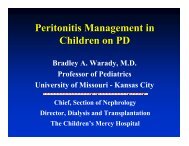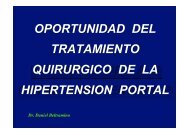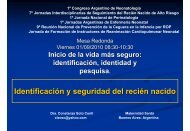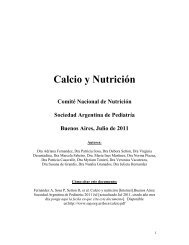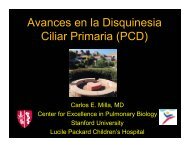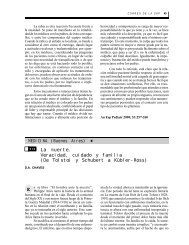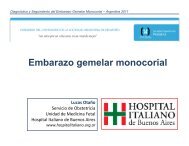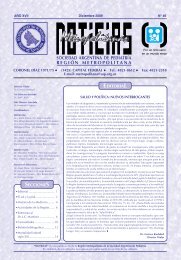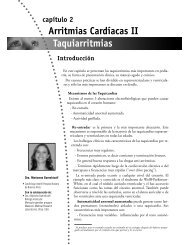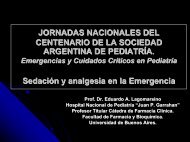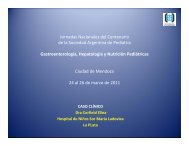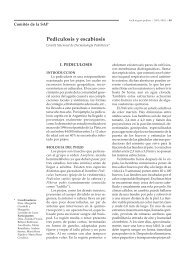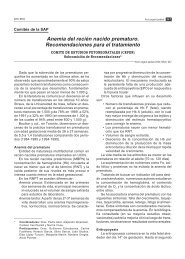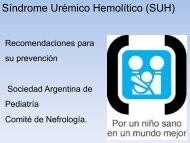Dra. Marina Orsi.
Dra. Marina Orsi.
Dra. Marina Orsi.
You also want an ePaper? Increase the reach of your titles
YUMPU automatically turns print PDFs into web optimized ePapers that Google loves.
Congreso de Pediatría Pediatr a Ambulatoria<br />
TREN PEDIATRICO<br />
¿Que Que hay de nuevo en Reflujo<br />
Gastroesofágico? Gastroesof gico? .<br />
<strong>Dra</strong>. <strong>Marina</strong> <strong>Orsi</strong>.
RGE: RGE<br />
movimiento retrógrado<br />
del contenido gástrico<br />
hacia el esófago.<br />
• Fisiológico Fisiol gico y normal<br />
• Asintomático Asintom tico o regurgitación regurgitaci n / vómito v mito<br />
• Se resuelve espontáneamente<br />
espont neamente<br />
• Postprandial<br />
• Durante primeros 2 años a os de vida
Capacidad Gástrica G strica<br />
• La distensión gástrica sería un potente estímulo<br />
para la RT.<br />
• Vaciamiento gástrico.<br />
La extensiòn proximal se relaciona con la<br />
intensidad de los sìntomas s ntomas y con el movimiento<br />
• Menor longitud<br />
• Menor capacidad<br />
Gravedad<br />
Adulto<br />
Adult<br />
o<br />
Iactante<br />
Emerenzian y col.<br />
AJG-2005 AJG 2005
Regurgitador o Vomitador “Feliz “ :<br />
Es el lactante que regurgita y / o vomita con<br />
variable intensidad , sin otro síntoma<br />
acompañante. Crece bien y está sonriente.<br />
Tiene Reflujo Gastroesofágico Fisiológico.
Pharynx<br />
Esophagus<br />
Crural<br />
diaphragm<br />
Pylorus<br />
Relajaciones transitorias del EEI<br />
LES<br />
UES<br />
Angle<br />
of His<br />
Stomach<br />
Tracings reprinted from Kawahara et al, Gastroenterology 1997;113:399<br />
Las RT del EEI son la<br />
causa + frecuente de<br />
RGE en niños ni os y<br />
adultos.<br />
RT se define como<br />
disminución disminuci n abrupta<br />
de la P del EEI, no<br />
relacionada a<br />
deglución degluci n o<br />
perístasis per stasis.<br />
RT ocurren en<br />
individuos sanos, pero<br />
en el RGE patològico<br />
su frecuencia y<br />
duración duraci n es mayor.<br />
mayor
Enfermedad por Reflujo Gastroesofágico.<br />
Es el lactante o niño con síntomas digestivos y /<br />
o extradigestivos que se vinculan al daño tisular<br />
producido por la intensidad o frecuencia de los<br />
episodios de reflujo.<br />
Se denomina :<br />
Reflujo Gastroesofágico Patológico.
Vómitos. mitos.<br />
Regurgitaciones.<br />
Naúseas. Na seas.<br />
SÍNTOMAS NTOMAS<br />
Epigastralgia .<br />
Pirosis.<br />
Hematemesis.<br />
Arcadas. Arcadas.<br />
Melena.
Anemia.<br />
Irritabilidad.<br />
Retardo ponderal.<br />
B.O.R. - Asma<br />
SÍNTOMAS NTOMAS .<br />
Tos Recurrente.<br />
Estridor-Laringitis<br />
Estridor Laringitis<br />
Dolor torácico. tor cico.<br />
E .A .A .V.<br />
Neumonías Neumon as reiteradas. Sme de Sandifer.
Posibles mecanismos involucrados en la<br />
enfermedad respiratoria relacionada al RGE<br />
Esófago<br />
Reflujo<br />
Aferentes<br />
Esofágicos<br />
NEURAL<br />
Aferentes v. aérea<br />
Arbol Traqueobronquial<br />
Aspiración<br />
QUIMICA<br />
Liberación de<br />
mediadores<br />
inflamatorios<br />
Eferentes de<br />
la v. aérea<br />
Obstrucción Luminal<br />
Material<br />
aspirado<br />
Moco<br />
Edema<br />
Contracción<br />
Músculo liso<br />
Bronquial
OBSTRUCCIÓN de la VIA AEREA<br />
Posibles mecanismos<br />
LUZ<br />
(material aspirado, moco secretado)<br />
LAMINA PROPIA (edema)<br />
MÚSCULO (bronco-espasmo,<br />
laringo - espasmo )<br />
BRONQUIO: Tres lugares potenciales de obstrucción de la<br />
vía aérea. La luz bronquial puede encontrarse disminuída<br />
por material de origen extra o intra-pulmonar. Por otro<br />
lado la lámina propia puede estar engrosada por edema y<br />
por último la contracción muscular puede estrechar la luz
Diagnóstico Diagn stico Diferencial .<br />
Trastornos metabólicos.<br />
metab licos.<br />
Síndrome ndrome Pilórico Pil rico.<br />
Alergia a la proteína prote na de la<br />
leche de vaca.<br />
Infecciones (gastroenteritis-<br />
inf.urinaria )<br />
Hipertensión<br />
Hipertensi n<br />
endocraneana.<br />
endocraneana<br />
Trastornos<br />
hidroelectrolíticos.<br />
hidroelectrol ticos.<br />
Gastritis -Duodenitis Duodenitis.<br />
Enf.úlcerop<br />
Enf. lceropéptica. ptica.
DIAGNÓSTICO<br />
DIAGN STICO<br />
HISTORIA CLÍNICA CL NICA<br />
Edad al comienzo del cuadro clínico. cl nico.<br />
Síntomas ntomas al inicio y en el tiempo. tiempo<br />
Evolución Evoluci n según seg n tipo de alimentación.<br />
alimentaci n.<br />
Curva de crecimiento ( Peso – Talla )<br />
Asociación Asociaci n con síntomas ntomas ORL o con<br />
Síntomas ntomas respiratorios o con<br />
Síntomas ntomas neurológicos<br />
neurol gicos
DIAGNÓSTICO<br />
DIAGN STICO<br />
Seriada Gastroduodenal bajo<br />
radioscopía.<br />
radioscop a.<br />
Video-Degluci<br />
Video Deglución n con S.G.D.<br />
Endoscopía Endoscop a alta con biopsias. biopsias<br />
pHmetría pHmetr a de 24 horas. horas<br />
Manometría Manometr a Esofágica. Esof gica.<br />
Gamma - cámara. mara.<br />
Impedanciometría Impedanciometr a Intraluminal Multicanal<br />
con phmetria / manomentria de 24 hs.<br />
hs
Hernia Hiatal<br />
con RGE
Aspiración
Gamma-Cámara
pH-metría patológica
pH-metría normal
Correlación sintomática apnea - rge<br />
pnea
1ª<br />
pH<br />
2ª<br />
pH<br />
3ª<br />
pH<br />
pHmetría en un paciente con EAAV<br />
A<br />
IR:28,2%<br />
IR:6,9%<br />
IR:1.8%
Rol de la endoscopía endoscop a en el RGE patológico<br />
patol gico<br />
Para evaluar la presencia o no del daño da o mucoso y<br />
la severidad del mismo. mismo<br />
Cuando los síntomas ntomas son importantes y la<br />
pHmetría pHmetr a es normal.<br />
Cuando la clínica cl nica parece sugerir otros<br />
diagnósticos diagn sticos ej : esofagitis eosinofílica eosinof lica ; gastritis<br />
por Helicobacter Pylori .<br />
Cuando los síntomas s ntomas no ceden con el tratamiento.<br />
tratamiento<br />
En el seguimiento del RGE patológico patol gico persistente.<br />
persistente<br />
Previo a la cirugía cirug a del RGE.<br />
Cuando se decide dar de alta al paciente.<br />
paciente
Esófago<br />
Normal<br />
Esofagitis
Esofagitis Eosinofílica
Impedanciometría Impedanciometr a Intraluminal Multicanal<br />
con phmetría phmetr a de 24 hs. hs<br />
Detecta RGE ácido cido y no ácido cido .<br />
Puede establecer diagnóstico diagn stico en pacientes con<br />
síntomas ntomas refractarios durante el tratamiento médico m dico.<br />
Permite evaluarlos con o sin medicación.<br />
medicaci<br />
Correlaciona síntomas s ntomas con episodios ácidos cidos o no<br />
ácidos. cidos.<br />
Cuantifica el patrón patr n de reflujo y la correlación correlaci n<br />
sintomática sintom tica tambien en el período per odo post-prandial.<br />
post prandial.<br />
Es capaz de diagnosticar el reflujo supra-esof supra esofágico gico.<br />
Puede. monitorear a los lactantes pequeños peque os con<br />
alimentación alimentaci n muy frecuente
Impedance –pH Catheter<br />
Pediatric Model<br />
13 cm<br />
11 cm<br />
9 cm<br />
7 cm<br />
5 cm<br />
3 cm<br />
6 impedance channels<br />
pH – 3 cm<br />
1 pH channel<br />
9
Deglución. Reflujo
Reflujo No Acido
Pediatric Gastroesophageal Reflux Clinical Practice Guidelines:<br />
Joint Recommendations of the North American Society for<br />
Pediatric Gastroenterology, Hepatology, and Nutrition<br />
( NASPGHAN ) and the<br />
European Society for Pediatric Gastroenterology, Hepatology, and<br />
Nutrition (ESPGHAN)<br />
Co-Chairs: Co Chairs: Yvan Vandenplas and yColin D. Rudolph<br />
Committee Members: zCarlo Di Lorenzo, §Eric Eric Hassall, jjGregory<br />
Liptak,Lynnette Mazur, #Judith Sondheimer, Annamaria Staiano,<br />
yyMichael Thomson,zzGigi Veereman-Wauters, Veereman Wauters, and §§Tobias §§ Tobias G. Wenzl<br />
UZ Brussel Kinderen, Brussels, Belgium, {Division of Pediatric Gastroenterology, Gastroenterology,<br />
Hepatology, and Nutrition,<br />
Children’s Children s Hospital of Wisconsin, Medical College of Wisconsin, Milwaukee, Milwaukee,<br />
WI, USA, {Division of Pediatric Gastroenterology,<br />
Nationwide Children’s Children s Hospital, The Ohio State University, Columbus, OH, USA, §Division Division of Gastroenterology,<br />
Department of Pediatrics, British Columbia Children’s Children s Hospital/University of British Columbia, Vancouver, BC, Canada, Canada<br />
jj Department of Pediatrics, Upstate Medical University, Syracuse, Syracuse,<br />
NY, USA, Department of Pediatrics, University University of Texas Texas Health Health<br />
Sciences Center Houston and Shriners Hospital for Children, Houston, Houston,<br />
TX, USA, #Department of Pediatrics, Pediatrics, University of Colorado<br />
Health Sciences Center, Denver, CO, USA, Department of Pediatrics, Pediatrics,<br />
University of Naples ‘‘Federico ‘‘ Federico II,’’ II, ’’ Naples, Italy,<br />
{{Centre for Paediatric Gastroenterology, Sheffield Children’s Children s Hospital, Western Bank, Sheffield, UK,<br />
{{Pediatric Gastroenterology & Nutrition, Queen Paola Children’s Children s Hospital- Hospital ZNA, Antwerp, Belgium, and§§ and§§Klinik<br />
Klinik fu¨r fu r Kinder- Kinder und<br />
Jugendmedizin, Universita¨tsklinikum Universita tsklinikum der RWTH Aachen, Aachen, Germany<br />
Journal Journal<br />
of Pediatric Gastroenterology and Nutrition49:498<br />
Nutrition49:498–547<br />
547 # 2009
pHmetría pHmetr a de 24 horas ( Guidelines 2009 )<br />
This test is a valid quantitative measure of esophageal acid exposure with<br />
established normal ranges.<br />
In pH studies performed with antimony electrodes, an RI > 7% is<br />
considered abnormal, an RI < 3% is considered normal , and an RI<br />
between 3% and 7% is indeterminate.<br />
However, the severity of pathologic acid reflux does not correlate consistently<br />
with symptom severity or demonstrable complications.<br />
.<br />
Esophageal pH monitoring is useful for evaluating the efficacy of<br />
antisecretory therapy. It may be useful to correlate symptoms (eg, cough, chest<br />
pain) with<br />
acid reflux episodes and to select those infants and children with wheezing or<br />
respiratory symptoms in whom GER is an aggravating factor.<br />
The sensitivity, specificity, and clinical utility of pH monitoring for<br />
diagnosis and management of possible extraesophageal complications of<br />
GER are not well established
Impedanciometría Impedanciometr a Intraluminal Multicanal –<br />
pHmetría pHmetr a de 24 hs<br />
This test detects acid, weakly acid , and nonacid reflux episodes.<br />
It is superior to pH monitoring alone for evaluation of the temporal<br />
relation between symptoms and GER.<br />
The technology is especially useful in the postprandial period or at other<br />
times when gastric contents are nonacidic. The relation between weakly<br />
acid reflux and symptoms of GERD requires clarification.<br />
Measurement of other parameters such as SI or SAP may be of additional<br />
value to prove symptom association with reflux, especially when<br />
combined with MII .<br />
Whether combined esophageal pH and impedance monitoring will<br />
provide useful measurements that vary directly with disease severity,<br />
prognosis, and response to therapy in pediatric patients has yet to be<br />
determined.
Tratamiento de Prueba con IBP<br />
An uncontrolled trial of esomeprazole therapy in adolescents with heartburn<br />
,epigastric pain, and acid regurgitation showed complete resolution of symptoms<br />
in 30% to 43% by 1 week, but the responders increased to 65% following 8 weeks<br />
of treatment .<br />
Another uncontrolled treatment trial of pantoprazole in children ages 5 to 11 years<br />
reported greater symptom improvement at 1 week with one 40-mg dose compared<br />
with one 10-mg or 20-mg dose (64). After 8 weeks all of the treatment groups<br />
improved. Similar improvement in symptoms over time has been observed in<br />
adults with erosive esophagitis (198,199).<br />
One study of infants with symptoms suggestive of GERD who were<br />
treated empirically with a PPI showed no efficacy over placebo<br />
The 2-week ‘‘PPI test’’ lacks adequate specificity and sensitivity for use in<br />
clinical practice.<br />
In an older child or adolescent with symptoms suggesting GERD, an<br />
empiric PPI trial is justified for up to 4 weeks.<br />
Improvement following treatment does not confirm a diagnosis of GERD because<br />
symptoms may improve spontaneously or respond by a placebo effect.<br />
There is No evidence to support an empiric trial of pharmacologic<br />
treatment in infants and young children as a diagnostic test of GERD.
Uso de Inhibidores de Bomba de protones en niños ni os<br />
Journal of Pediatric Gastroenterology and Nutrition<br />
49:498–547 49:498 547 # 2009 by European Society for Pediatric Gastroenterology, Hepatology, Hepatology,<br />
and Nutrition and<br />
North American Society for Pediatric Gastroenterology, Hepatology, Hepatology,<br />
and Nutrition<br />
PPIs currently approved for use in<br />
children in<br />
NorthAmerica<br />
NorthAmerica<br />
are omeprazole,<br />
lansoprazole, and esomeprazole.<br />
esomeprazole<br />
At this moment, in Europe, Europe only<br />
omeprazole and esomeprazole are<br />
approved.<br />
No PPI has been approved for<br />
use in infants younger than 1 year<br />
of age.<br />
Most studies of PPIs in children are<br />
open-label open label and uncontrolled.<br />
In children, as in adults, PPIs are<br />
highly efficacious for the treatment of<br />
symptoms due to GERD and the<br />
healing of erosive disease.<br />
PPIs have greater efficacy than<br />
H2RAs.<br />
Children 1 to 10 years of age<br />
appear to require a higher<br />
dose per kilogram for some<br />
PPIs than adolescents and<br />
adults.<br />
Young children require<br />
higher per kilogram doses to<br />
attain the same acid blocking<br />
effect or area under the curve<br />
(304–306). (304 306). This may not<br />
apply to all of the PPIs(307).<br />
There are few<br />
pharmacokinetic data for<br />
PPIs in infants, but studies<br />
indicate that infants younger<br />
than 6 months may have a<br />
lower per-kilogram per kilogram dose<br />
requirement than older<br />
children and adolescents<br />
(308,309).
Uso de Inhibidores de Bomba de protones en niños ni os<br />
Journal of Pediatric Gastroenterology and Nutrition<br />
49:498–547 49:498 547 # 2009 by European Society for Pediatric Gastroenterology, Hepatology, Hepatology,<br />
and Nutrition and<br />
North American Society for Pediatric Gastroenterology, Hepatology, Hepatology,<br />
and Nutrition<br />
PPIs inhibit acid secretion by blocking Naþ– Naþ<br />
Kþ- Kþ ATPase, the final common pathway of<br />
parietal cell acid secretion, often called the<br />
proton pump.<br />
Studies in adults have shown that PPIs<br />
Despite their efficacy in the management<br />
of acid related disorders, PPIs have<br />
limitations as a consequence of their<br />
pharmacologic characteristics.<br />
produce higher and faster healing rates for<br />
<br />
erosive esophagitis than H2RAs, which in turn<br />
They must be taken once per day before<br />
breakfast and must be protected from<br />
are better than placebo (122).<br />
gastric acid by enteric coatings.<br />
Bioavailability of PPIs is decreased if<br />
The superior efficacy of PPIs is largely<br />
they are not taken before meals. meals.<br />
because of their ability to maintain intragastric<br />
pH at or above 4 for longer periods and<br />
<br />
and<br />
toinhibit meal-induced meal induced acid secretion, a<br />
characteristic notshared by H2RAs. In contrast<br />
with H2RAs, H2RAs,<br />
the effect ofPPIs does not<br />
diminish with chronic use.<br />
However, taking the medications before<br />
meals effectively delays absorption and<br />
onset of their antisecretory effect. Most<br />
available PPIs are therefore regarded as<br />
‘‘delayed ‘‘ delayed release’’ release’’<br />
preparations.<br />
The potent suppression of acid secretion by<br />
PPIs also results in decrease of 24-hour 24 hour<br />
intragastric volumes, thereby facilitating<br />
gastric emptying and decreasing volume<br />
reflux.<br />
Achievement of maximal acid<br />
suppressant effect can take up to<br />
4 days.
Objetivo en el manejo de la ERGE en niños ni os<br />
según seg n las Guías Gu as NASPGHAN*<br />
“mejorar mejorar o resolver los síntomas s ntomas presentes<br />
y las complicaciones del reflujo<br />
gastroesofágico, gastroesof gico, con intervenciones que<br />
tengan pocos o ningun efecto adverso y<br />
con reanudación reanudaci n funcional.” funcional.<br />
* North American Society for Pediatric Gastroenterology, Hepatology and Nutrition<br />
Rudolph CD et al. J Pediatr Gastroenterol Nutr 2001;32 Suppl 2:S1–31
TRATAMIENTO<br />
Lactante Vomitador.<br />
Vomitador<br />
Espesamiento de la alimentación:<br />
alimentaci n:<br />
casera o en base a fórmulas f rmulas “AR AR”.<br />
Cuidar el volumen en cada toma.<br />
Posición Posici n prona postprandial a 30º. 30<br />
Si no responde a éstos cambios ( 2 a 3<br />
semanas ) es posible intentar una serie<br />
de tratamiento y valorar la respuesta al<br />
mismo.
El iceberg del RGE<br />
Alternativas<br />
Terapéuticas<br />
Tratamiento<br />
farmacológico<br />
Cambio de<br />
hábitos<br />
Tratamiento<br />
quirúrgico<br />
La mayoría de los lactantes y niños mejoran con<br />
cambio de hábitos y dieta. Los más afectados requieren<br />
medicación y algunos pocos deberían ser intervenidos<br />
quirúrgicamente
Posición Posici n para lactantes con<br />
RGE
Proquinéticos<br />
Proquin ticos :<br />
Tratamiento Médico M dico.<br />
Metoclopramida:pasa Metoclopramida:pasa<br />
la barrera hematoencefálica, hematoencef lica, la dosis<br />
terapeútica terape tica y la dosis tóxica t xica son muy cercanas ,lo que facilita<br />
las intoxicaciones.<br />
Cisapride : 0.1mg-0.2mg 0.1mg 0.2mg / kg /dosis cada 6 hs. a 8 hs , con<br />
una dosis máxima m xima de 0.8mg/ kg / día. d a. Por el riesgo de<br />
prolongación prolongaci n del QT- QT QTc se recomienda realizar ECG previo<br />
y suspenderlo ante asociaciones medicamentosas o<br />
metabólicas metab licas de riesgo.<br />
Domperidona :0,3 mg / kg / día d a en 3 dosis diarias. Mismo<br />
efecto sobre el QT-QTc QT QTc y no está est aceptado por FDA y existen<br />
pocos estudios en Pediatría. Pediatr a.
Mecanismos y sitio de acción acci n de los<br />
proquinéticos<br />
proquin ticos
Las guías gu as NASPGHAN reconocen a los IBP como el<br />
tratamiento más m s efectivo en niños ni os con ERGE<br />
“los los IBP, son la terapia medicamentosa<br />
supresora del ácido cido más m s efectiva, efectiva,<br />
superior a H 2RAs RAs en el rescate de los síntomas s ntomas y<br />
en la curación curaci n de la esofagitis † ”<br />
† No todos los IBP estan actualmente aprobados para ser usados en Pediatría<br />
Rudolph CD et al. J Pediatr Gastroenterol Nutr 2001;32 Suppl 2:S1–31
Tratamiento Médico. M dico.<br />
ANTIÁCIDOS<br />
ANTI CIDOS: : El objetivo es disminuir el pH gástrico g strico y así as<br />
cambiar la calidad del material refluído reflu do , mejorar el<br />
clearence y favorecer el aumento de la Presión Presi n del EEI .<br />
Ranitidina: Ranitidina:<br />
(jarabe) :5 - 10 mg / kg / día d a oral cada 12 hs.<br />
Omeprazol : (polvo p/diluir):0,7 - 2,4 mg/ kg/día kg/d a c / 12 hs.<br />
Esomeprazol:(<br />
Esomeprazol<br />
:(polvo polvo para diluir): diluir) : 0,6 - 2mg/kg/d 1 a 2 t /d<br />
Lanzoprazol :(granulado p/ diluir) :0,5 - 1,5mg /kg/ d 1 t/d
Tratamiento Quirúrgico<br />
Quir rgico<br />
RGE que no responde a tratamiento médico m dico .<br />
Riesgo de complicaciones severas ej : Estenosis péptica p ptica -<br />
Esófago Es fago de Barrett.<br />
Episodios con riesgo de vida para el paciente.<br />
Persistencia de esofagitis severa a pesar del tratamiento<br />
médico. dico.<br />
En niños ni os con daño da o neurológico neurol gico al que se le realice una<br />
gastrostomía gastrostom a y presente RGE persistente.<br />
persistente
Cirugía Cirug a Antireflujo.<br />
Operación Operaci n de Nissen.<br />
Operación Operaci n de Thal.<br />
Operación Operaci n de Boix Ochoa.<br />
Hoy en día d a se puede realizar en forma convencional o<br />
por vía a laparoscópica<br />
laparosc pica inclusive ya existe una serie<br />
pediátrica pedi trica publicada con técnica t cnica endoscópica.<br />
endosc pica.<br />
Para establecer cual es el abordaje mas conveniente en<br />
cada caso, todavía todav a falta tiempo , que permita<br />
comparar las diferentes series.<br />
Las ventajas de cada técnica t cnica depende entre otras cosas<br />
del entrenamiento del equipo quirúrgico quir rgico
Gracias, por su atención.
Gracias por su atención .
Indicaciones del uso en RGE<br />
With regard to maintenance therapy, in a<br />
prospectivestudy of children whose erosive<br />
esophagitis had healed following 3 months of<br />
omeprazole therapy, only half maintained the<br />
remission of symptoms and endoscopic disease<br />
in a maintenance phase during which they<br />
received half the healing dose of PPI (316).<br />
In another study, patients whose erosive<br />
esophagitis healed after 3 months’ months omeprazole<br />
treatment (1.4 mg kg/ day) underwent double-<br />
blind randomization into 3 groups,receiving<br />
groups, receiving<br />
either maintenance therapy with omeprazole at<br />
half the healing dose, ranitidine, or placebo for<br />
6 months (130).<br />
In all 3 groups, few patients had a relapse of<br />
symptoms or of endoscopic esophagitis during<br />
or after maintenance therapy.<br />
There were important differences between these<br />
2 studies. Specifically, in the first study, the<br />
mean grade of esophagitis was higher, and 41%<br />
of patients had an underlying disorder<br />
predisposing to GERD<br />
In a retrospective study of 166<br />
children with erosive<br />
esophagitis unable to<br />
withdraw from PPIs for up to<br />
11 years (median 3.5 years),<br />
79% had at least 1 underlying<br />
condition predisposing them<br />
to GERD and 39% had HH<br />
(28).<br />
Thus, patients with lower<br />
grades of erosive esophagitis<br />
and without an underlying<br />
high-risk high risk condition may not<br />
require long-term long term PPI therapy<br />
after initial effective treatment. treatment<br />
<br />
In a recent study of adults<br />
with longterm PPI use, 27%<br />
were able to discontinue drug<br />
without relapse (452).
PPIs are recommended as initial therapy in<br />
children with erosive esophagitis.<br />
Indicaciones del uso en RGE:<br />
Initial treatment for 3 months is advised.<br />
If adequate control of symptoms is not<br />
achieved within 4 weeks, the dose of PPI can<br />
be increased.<br />
Patients who require higher PPI dose to control<br />
symptoms and produce healing are those with<br />
conditions that predispose to severe-chronic<br />
severe chronic<br />
GERD and those with higher grades of<br />
esophagitis or BE.<br />
In most cases, efficacy of therapy can be<br />
monitored by extent of symptom relief without<br />
routine endoscopic follow-up. follow up.<br />
Endoscopic monitoring of treatment efficacy<br />
may be useful in patients whose presenting<br />
signs and symptoms are atypical, who have<br />
persistent symptoms while taking adequate<br />
acid-suppressive acid suppressive drugs, or who had higher<br />
grades of esophagitis or esophageal stricture<br />
at presentation (see also Section 5.2.2)<br />
Follow up endoscopy is not<br />
routinely indicated in patients with<br />
nonerosive disease, particularly if<br />
they are asymptomatic on<br />
medication.<br />
Most patients require only 1 daily<br />
dose of PPI to obtain symptomatic<br />
relief and heal esophagitis<br />
(29,131,447,459).<br />
The optimum dosage regimen is to<br />
administer a once-daily once daily dose 15 to<br />
30 minutes before the first meal of<br />
the day.<br />
It is not necessary to make patients<br />
achlorhydric to relieve symptoms<br />
or heal esophagitis, and, in light of<br />
the data on infectious and other<br />
complications of acid suppression<br />
by H2RAs or PPIs, it is probably<br />
notdesirable notdesirable<br />
to do so.




